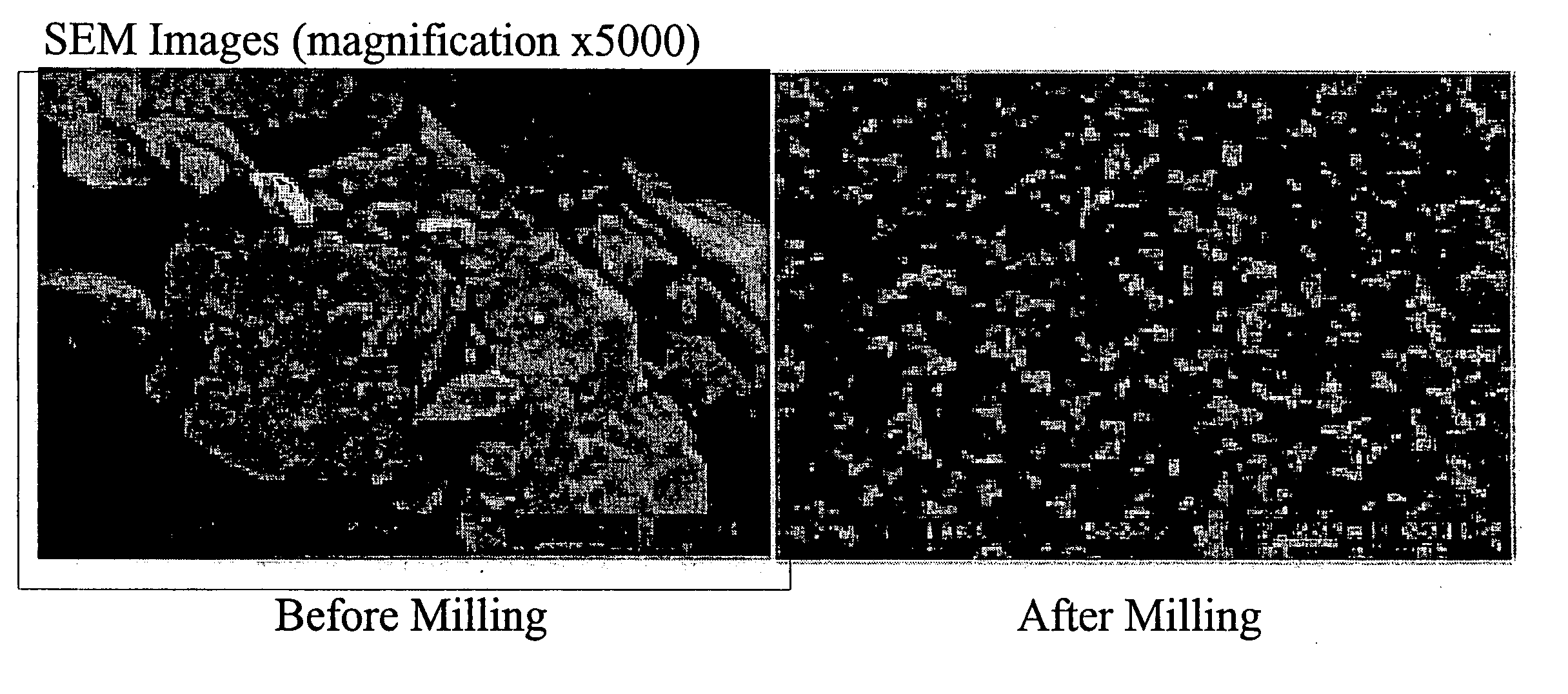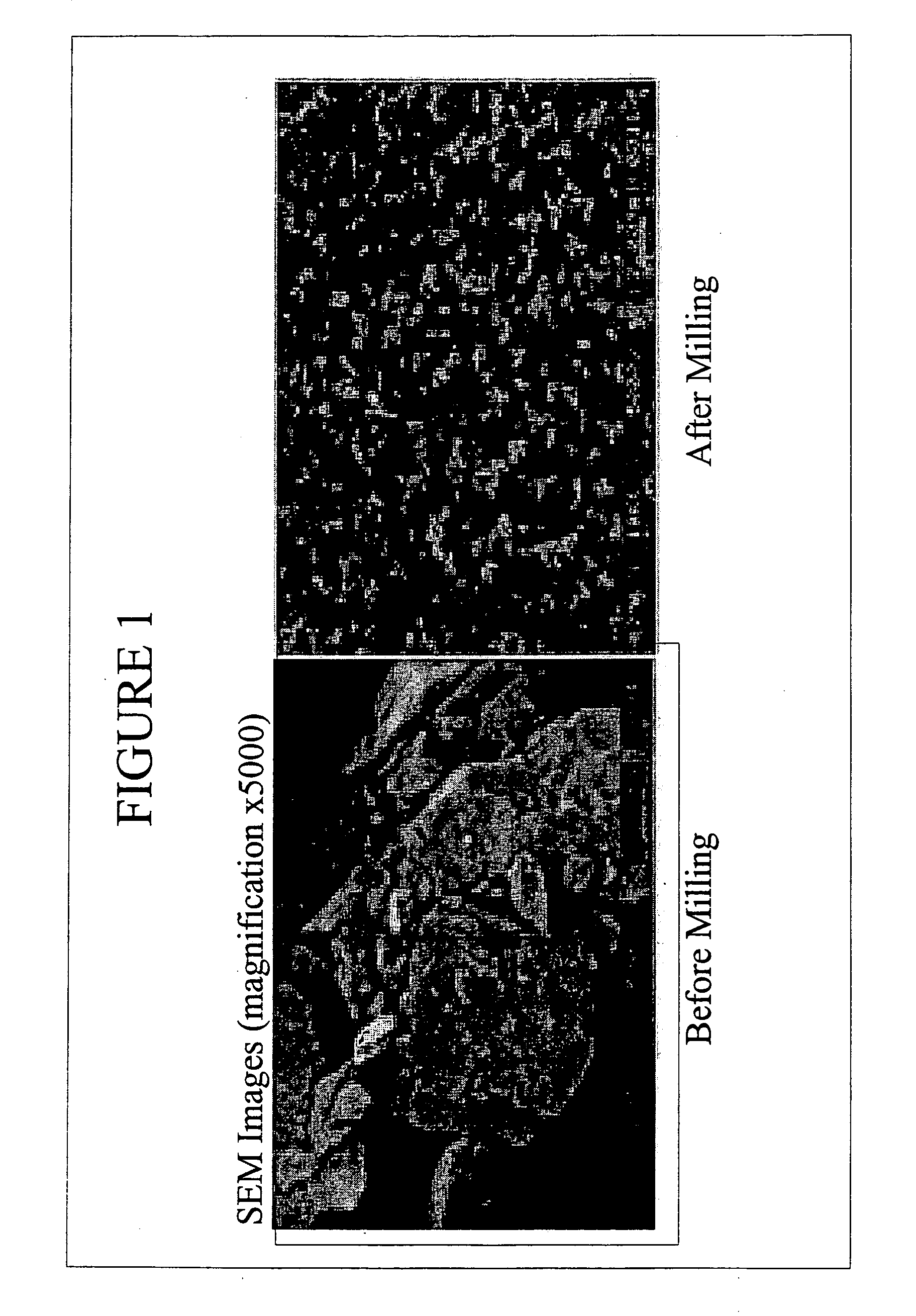Nanoparticulate insulin
- Summary
- Abstract
- Description
- Claims
- Application Information
AI Technical Summary
Benefits of technology
Problems solved by technology
Method used
Image
Examples
example 1
[0073] The purpose of this example was to prepare nanoparticulate insulin formulations using low energy milling techniques.
[0074] Insulin and one or more surface stabilizers, in the amounts shown in Table 1, were mixed with water to form a pre-milling slurry. This slurry was then added to a sealable vessel and rotated for from 1 to 4 days at a pre-set rotational speed (typically 100-200 rpm) on a roller mill using high wear zirconia grinding media (Tosoh Corporation, Tokyo, Japan) with a diameter of 0.8 mm. This low energy milling technique relies upon gravitational grinding mechanisms to break the particle size down, hence the use of heavy ceramic media.
[0075] Particle size distributions of the resultant insulin compositions were determined using a Horiba LA-910 light-scattering particle size analyzer (Horiba Instruments, Irvine, Calif.). The results shown in Table 1 were determined at 24 hours post milling. It is to be noted that the concentration of insulin in this Example was ...
example 2
[0078] The purpose of this example was to prepare nanoparticulate insulin formulations using high energy milling conditions.
[0079] Samples of insulin were prepared using a high energy attrition media mill, NanoMil™ (Elan Drug Delivery, King of Prussia, Pa.). A high energy mill is designed to apply a much higher rotational velocity to the particulate dispersion (100-6000 rpm, typically 5000 rpm), than that used in low energy milling processes. The elevated rotational velocity imparts very high shear conditions within the milling chamber. It is this shear force which causes the particle size reduction.
[0080] The media used in this milling technology is a much lighter, highly crosslinked polystyrene media. For preparation of nanoparticulate insulin compositions described in Table 3, 500 μm media was used. Other media sizes that could be used range from 50 μm to 500 μm. The samples were milled from about 30 minutes up to about 3 hours. Particle size distributions were determined using...
example 3
[0082] The purpose of this example is to examine nanoparticle insulin prepared in accordance with the invention and test the stability of the compositions over an extended storage period.
[0083] Nanoparticulate insulin was prepared in accordance with the procedure of Example 2. Milling was carried out until the insulin particles were found to have a mean particle size of 100 nm, with 90% of the particles less than 145 nm.
[0084]FIG. 1 shows SEM images of insulin particles before and after milling, clearly demonstrating the effect of the milling and, more importantly, the capacity of the surface stabilizers to prevent agglomeration of the insulin particles. Analysis of a sample of this material stored for six months at 5° C. revealed 90% of the insulin particles to be smaller than 145 nm.
PUM
| Property | Measurement | Unit |
|---|---|---|
| Length | aaaaa | aaaaa |
| Length | aaaaa | aaaaa |
| Length | aaaaa | aaaaa |
Abstract
Description
Claims
Application Information
 Login to View More
Login to View More - R&D
- Intellectual Property
- Life Sciences
- Materials
- Tech Scout
- Unparalleled Data Quality
- Higher Quality Content
- 60% Fewer Hallucinations
Browse by: Latest US Patents, China's latest patents, Technical Efficacy Thesaurus, Application Domain, Technology Topic, Popular Technical Reports.
© 2025 PatSnap. All rights reserved.Legal|Privacy policy|Modern Slavery Act Transparency Statement|Sitemap|About US| Contact US: help@patsnap.com



